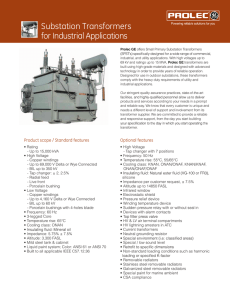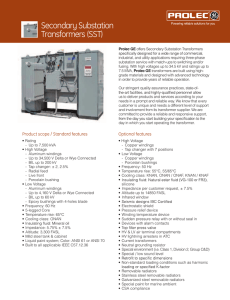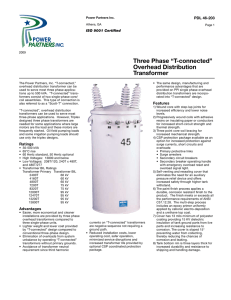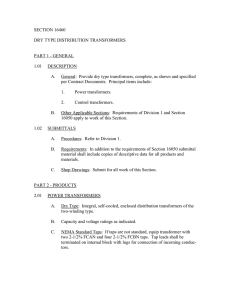SECTION 16461C - DRY TYPE
advertisement
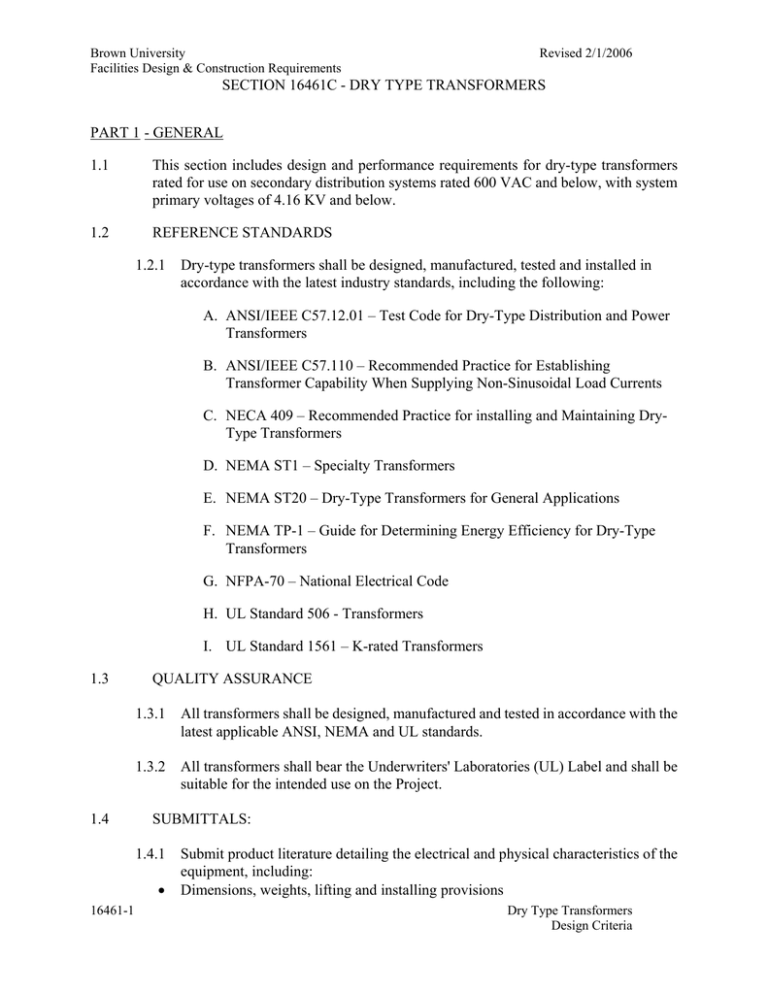
Brown University Facilities Design & Construction Requirements Revised 2/1/2006 SECTION 16461C - DRY TYPE TRANSFORMERS PART 1 - GENERAL 1.1 This section includes design and performance requirements for dry-type transformers rated for use on secondary distribution systems rated 600 VAC and below, with system primary voltages of 4.16 KV and below. 1.2 REFERENCE STANDARDS 1.2.1 Dry-type transformers shall be designed, manufactured, tested and installed in accordance with the latest industry standards, including the following: A. ANSI/IEEE C57.12.01 – Test Code for Dry-Type Distribution and Power Transformers B. ANSI/IEEE C57.110 – Recommended Practice for Establishing Transformer Capability When Supplying Non-Sinusoidal Load Currents C. NECA 409 – Recommended Practice for installing and Maintaining DryType Transformers D. NEMA ST1 – Specialty Transformers E. NEMA ST20 – Dry-Type Transformers for General Applications F. NEMA TP-1 – Guide for Determining Energy Efficiency for Dry-Type Transformers G. NFPA-70 – National Electrical Code H. UL Standard 506 - Transformers I. UL Standard 1561 – K-rated Transformers 1.3 1.4 QUALITY ASSURANCE 1.3.1 All transformers shall be designed, manufactured and tested in accordance with the latest applicable ANSI, NEMA and UL standards. 1.3.2 All transformers shall bear the Underwriters' Laboratories (UL) Label and shall be suitable for the intended use on the Project. SUBMITTALS: 1.4.1 • 16461-1 Submit product literature detailing the electrical and physical characteristics of the equipment, including: Dimensions, weights, lifting and installing provisions Dry Type Transformers Design Criteria Brown University Facilities Design & Construction Requirements • • • • • • • • • • • 1.4.2 1.5 Revised 2/1/2006 Voltage (primary and secondary) kVA rating Percent impedance Tap configurations Insulation system type and rated temperature rise Sound Level Design Impedance K-Factor Rating (where applicable) Manufacturer’s installation and maintenance manuals Energy Star Label compliance Basic Impulse Level (BIL) for transformers over 600 Volts. Submit manufacturer’s standard connection diagrams and installation instructions. DELIVERY, STORAGE AND HANDLING 1.5.1 Provide for delivery, storage and handling of transformers per the manufacturer’s guidelines. 1.5.2 Transformers delivered to the job site shall be inspected for damage caused in transit. 1.5.3 Store transformers per manufacturer’s requirements in a clean, dry and protected space until moved to final installation. PART 2 - PRODUCTS 2.1 16461-2 DRY-TYPE TRANSFORMERS – GENERAL REQUIREMENTS 2.1.1 Transformer ratings and types shall be selected to match the requirements of the primary service and the types of load served. In most cases, a general purpose type of transformer shall be adequate for the load. For applications requiring isolation transformers, such as for motor variable speed drives, utilize a rated Drive Isolationtype transformer. For applications where large harmonic loads are anticipated, utilize a non-linear load-type transformer. 2.1.2 Transformers shall be designed and manufactured in compliance with NEMA ST-20 and UL 1561. 2.1.3 Transformers shall be capable of operating at 100% of nameplate rating continuously while in an ambient temperature of 40O C (104OF). 2.1.4 Transformer insulation materials shall be fire retardant and shall not support combustion. 2.1.5 Transformer windings and terminations shall be copper. Dry Type Transformers Design Criteria Brown University Facilities Design & Construction Requirements 2.1.6 Revised 2/1/2006 Transformer sound levels shall not exceed the levels indicated below: Transformer KVA Maximum Sound Level (db) 15 - 50 51 - 150 151 - 300 301 - 500 45 50 55 60 2.1.7 Three phase transformers shall be wound in a Delta-Wye configuration unless otherwise required for the application. 2.1.8 Transformer core and coil assembly shall be grounded to the transformer enclosure by means of a visible, flexible copper grounding strap. 2.1.9 Enclosures for transformers shall be fabricated of minimum 12-gauge steel, properly cleaned, degreased and painted per the manufacturer’s standard practice. Enclosures for indoor applications shall be NEMA 2 drip-proof rated, with ventilation openings protected against falling dirt. Enclosures for exterior applications shall be rated NEMA 3R minimum. 2.1.10 Maximum temperature at the top of the enclosure shall be 90 degrees C. 2.2. TRANSFORMERS – GENERAL PURPOSE TYPE 2.2.1 Transformer insulation type shall be as follows: a. Less than 15 KVA: 185 degrees C insulation system with maximum 115 degrees C rise. b. 15 KVA and above: 220 degrees C insulation system with maximum 115 degrees C rise. 2.2.2 Transformers shall conform to NEMA TP-1 requirements for energy efficiency and be Energy-Star listed. 2.2.3 Taps: a. 3 through 12 KVA: two 5% taps below rated primary voltage b. 15 KVA and above: six 2.5% taps, 2 above and 4 below rated primary voltage. 2.2.4 Core and Coil Assemblies: a. For transformers rated 9KVA and below, completely encapsulate the core and coil windings in a resin and aggregate to provide a moisture-proof and shock resistant seal, and to provide reduced sound levels. b. For transformers rated 15 KVA and above, core and coil assemblies shall be 16461-3 Dry Type Transformers Design Criteria Brown University Facilities Design & Construction Requirements Revised 2/1/2006 impregnated with non-hygroscopic, thermosetting varnish to reduce hot spots and seal out moisture. Mount assemblies to the transformer case with vibration-resistant pads. 2.3. 2.4. 16461-4 TRANSFORMERS – DRIVE ISOLATION TYPE 2.3.1 Isolation-type transformers shall generally be utilized when more than 20% of the load will be comprised of variable frequency motor drives or similar three-phase rectifier type loads. 2.3.2 Transformer windings shall be specially braced to withstand the thermal and mechanical stresses of DC drive current spikes. 2.3.3 Transformer windings shall incorporate an isolated and shielded secondary winding to provide greater isolation of drive “noise” coupling back to the primary windings. 2.3.4 Isolation transformer insulation type shall be as follows: a. 7.5 KVA and above: 220 degrees C insulation system with maximum 115 degrees C rise. 2.3.5 Taps: a. 5 KVA and above: two 5% taps, 1 above and 1 below rated primary voltage. 2.3.6 Core and Coil Assemblies: shall be impregnated with non-hygroscopic, thermosetting varnish to reduce hot spots and seal out moisture. Mount assemblies to the transformer case with vibration-resistant pads. TRANSFORMERS – NON-LINEAR LOAD TYPE 2.4.1 Non-linear load type (K-rated) transformers shall generally be utilized when more than 50% of the load will be comprised of single-phase computers or similar electronic power supply loads. K-factor shall be specified as required for the project. In general, K ratings of 4 or 13 shall be specified. 2.4.2 Transformer windings shall be specially braced to withstand the thermal and mechanical stresses of harmonic currents and voltages. 2.4.3 Transformer windings shall incorporate an isolated and shielded secondary winding to provide greater isolation of harmonic “noise” coupling back to the primary windings. 2.4.4 Transformer windings shall incorporate a 200% rated neutral winding and doublecapacity neutral terminations. 2.4.5 Isolation transformer insulation type shall be as follows: a. 15 KVA and above: 220 degrees C insulation system with maximum 115 degrees C rise. Dry Type Transformers Design Criteria Brown University Facilities Design & Construction Requirements Revised 2/1/2006 2.4.5 Taps: a. 500 KVA and below: six 2.5% taps, 2 above and 4 below rated primary voltage. b. 750 KVA and above: six 3.5% taps, 2 above and 4 below rated primary voltage. 2.4.6 Core and Coil Assemblies: shall be impregnated with non-hygroscopic, thermosetting varnish to reduce hot spots and seal out moisture. Mount assemblies to the transformer case with vibration-resistant pads. PART 3 - EXECUTION 3.1 INSTALLATION: 3.1.1 Transformers shall be installed in accordance with Article 450 of the National Electric Code (NEC) and the manufacturer's instructions 3.1.2 Provide proper spacing from walls in accordance with Articles 450-21 and 450-22 of the NEC to insure fire ratings of adjacent surfaces, for proper transformer ventilation and cooling. 3.1.3 Mounting Considerations: • 1-15 kVA: Suitable for wall mounting. • 30-75 kVA: Suitable for floor or trapeze mounting. • Larger than 75 kVA: Suitable for floor mounting. . 3.1.4 Provide vibration isolating pads suitable for isolating transformer noise and vibration from the building structure and use a minimum 2 foot length of flexible metal conduit to minimize noise transmission. 16461-5 3.1.5 Provide concrete housekeeping pad for floor-mounted transformers. 3.1.6 Transformer grounding shall be in accordance with Article 250 of the NEC. 3.1.7 Verify final connections for proper application and workmanship prior to energizing. 3.1.8 Verify that all internal shipping braces and brackets are removed. 3.1.9 Check primary and secondary voltages and make appropriate tap adjustments after transformer energization to provide optimum voltage conditions to the utilization equipment. 3.1.9 Transformer installation shall be left neat and clean with all foreign material removed from inside and around enclosures. Dry Type Transformers Design Criteria Brown University Facilities Design & Construction Requirements 3.2 Revised 2/1/2006 IDENTIFICATION 3.2.1 Label each transformer with laminated plastic nameplate, secured to the case with corrosion-resistant screws. END OF SECTION 16461 16461-6 Dry Type Transformers Design Criteria
